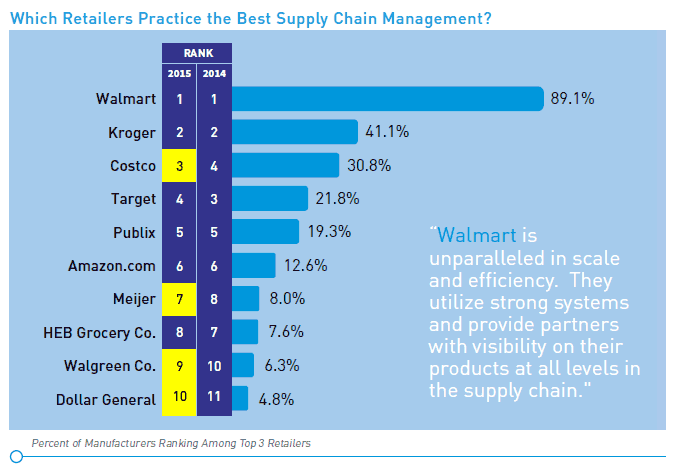Slave Labor in Retail Supply Chains?
Use of slave labor by suppliers is fast becoming a major retail supply chain risk.
The food supply chain is the latest sector to come under the microscope. Many reports of slave, forced or child labor have recently surfaced, especially with regards to seafood from Asian sources.
Supply Chain Digest Says... |
 |
| Kantar, taking over the methodology first employed by the old Cannondale Associates, uses the interesting approach of having vendors rank retailers on a number attributes, including supply chain management. |
 |
|
|
The issue is a serious one - a group of California law firms have sued name-brand companies doing business in California, such as Hershey, Mars, Nestle and Costco Wholesale, hoping to use the state's consumer protection laws to put the issue squarely in front of shoppers.
The suit asks that the words "This item may be the product of slave labor" be required on the packaging of some items. In December , Nestle prevailed in Los Angeles, where a federal
judge agreed there's no requirement to warn consumers about seafood from Thailand. However, the lawyers behind that suit have vowed to appeal, while one of the firms will argue a similar case against Costco in San Francisco in early 2016.
Visit the Retail Vendor Performance Management home page to learn more
and subscribe to the monthly newsletter.
In 2015, UK's The Guardian newspaper and the Associated Press wrote articles on widespread indentured servitude on Thai fishing boats, where starvation, beatings and even murder were alleged to occur, triggering an outcry among human rights groups. The California lawsuits soon followed.
Across retail sectors, this issue is not going away, and retailers would be well served to get proactive on this issue within their supply bases soon.
Top Retail Supply Chains
Did you catch the annual Kantar Retail list of the top 10 retail supply chains released late in 2015?
The universe for evaluation is limited to retailers connected to consumer packaged goods, such as mass merchants, grocers, warehouse clubs, and drug stores, leaving out soft goods and specialty retailers.
Kantar, taking over the methodology first employed by the old Cannondale Associates, uses the interesting approach of having vendors rank retailers on a number attributes, including supply chain management. Scores are based on the percentage of manufacturers rating a retailer as being one of the top three performers in a given category.
In this year's report, Walmart as usual finished on top in supply chain, and in dominating fashion, with a score of 89.1%, more than double #2 Kroger's score of 41.1%. The rest of the top 10: (3) Costco; (4) Target; (5) Publix; (6) Amazon; (7) Meijer; (8) HEB; (9) Walgreen's; and (10) Dollar General.

The rankings were similar in terms of "Best Category Management / Buying Teams," with Walmart again on top, but with a less dominant score of 58.8%, again ahead of #2 Kroger at 50.6%. The rest of the top 10 in this category: (3) Target;
(4) Costco; (5) Meijer; (6) HEB; (7) Publix; (8) Walgreen's;
(9) Wegmans; and (10) CVS.
Could a similar approach work in soft goods retail? We are taking a look.
Omnichannel Creating Retail Winners and Losers, RSR Finds
The analysts at Retail Systems Research (RSR) recently summarized some survey findings relative to how omnichannel commerce is impacting retail supply chain strategies.
"When it comes to the supply chain, retailers have spent the last 40 years optimizing the buying side of their businesses, perfecting mass merchandising strategies to deliver the lowest cost-of-goods for highly rationalized assortments," RSR writes. "But given all of the changes to the selling side of the retail model that have resulted from consumers' recent revolt against a "sea of sameness", the supply chain has come under a lot of pressure."
An RSR survey, for example, found that 97% of retail "winners" were moving sourcing and replenishment closer to the point of demand, versus 82% of other retailers. 94% of winners are switching to new low cost countries from more established LCCs, versus 76% of others.
New omnichannel order fulfillment capabilities, of course, are a top concern and challenge for retailers, RSR finds.
"It's clear that while some retailers complain that their supply chains (and their supply chain partners) lack speed, power, and capability, winners know their supply chain needs to be modernized to meet new demands," RSR observes.
The analysts also believe that retail winners put a lot more emphasis on fulfillment options designed to encourage customers to go to the store.
Clearly, improved retail vendor performance management will be a key part of overall success for retail winners in an omnichannel world.
Your Comments/Feedback
|